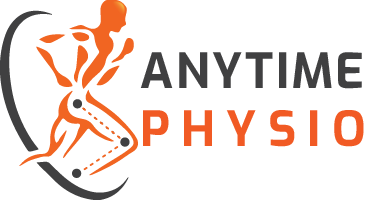PHYSIOTHERAPY FOR ELBOW PAIN
Learn how we treat elbow pain & injuries
at Anytime Physio
INTRODUCTION
Elbow and forearm pain often affects people who are required to repetitively grip for work or sport. For example, sports such as tennis, golf and rock climbing place repetitive strain on the muscles of the forearm. Due to the repetitive use, these sports tend to lead to overuse injuries of the forearm and elbow. The most common areas of pain are the elbow origins of the wrist and hand extensor and flexor muscles. Pain at the extensor origin, or the lateral epicondyle of the elbow, is called lateral epicondylalgia or “Tennis Elbow”. Conversely, pain at the flexor origin, or the medial epicondyle of the elbow, is called medial epicondylalgia or “Golfer’s Elbow”. Rock climbers can experience both tennis elbow and golfer’s elbow.
Our physiotherapists are experts in evidence-based treatment of both tennis elbow and golfer’s elbow. Anytime Physio also treats more complex conditions including elbow fractures, distal biceps pain and interosseous membrane tears.
ANATOMY OF THE ELBOW AND FOREARM
The elbow and forearm is made up of the humerus (the arm bone), the radius and the ulna. The muscles on the palm side of the forearm are called the wrist and hand flexors, while the muscles on the back of the forearm and elbow are called the wrist and hand extensors. These muscles are involved in moving the wrist up and down, turning the palm up and down, moving the fingers and gripping with the hand.
The biceps brachii and triceps brachii muscles attach into the elbow from the arm. These muscles produce the primary actions of the elbow which are elbow flexion and extension (bending and straightening the elbow).
Watch the video below to learn more about the anatomy of the elbow.
COMMON CONDITIONS OF THE ELBOW AND FOREARM
While the most common conditions that cause elbow pain are Tennis Elbow and Golfer’s Elbow, there are many other reasons you could be experiencing elbow pain. These include:
- Cubital Tunnel Syndrome
- Ligamentous Injuries
- Lateral Epicondylalgia / Epicondylitis (Tennis Elbow)
- Medial Epicondylalgia / Epicondylitis (Golfer’s Elbow)
- Olecranon Bursitis
- Fractures
- Olecranon fracture
- Radial head fracture
- Olecranon Fracture
- Osteochondritis Dissecans of the Elbow
- Ulnar Nerve Entrapment
HOW DO PHYSIOS TREAT ELBOW PAIN?
Assessment of the Elbow
Your physio will perform a thorough examination including subjective assessment and physical examination of the elbow and forearm. This will include an assessment of pain-free grip strength, the range of movement of the elbow and hand and strength of the muscles of the forearm. Your physio will then perform a manual assessment of the area of pain, looking for areas of tenderness in the elbow and forearm.
All of this information helps your physio determine the correct diagnosis and the best treatment options.
Treatment of the Elbow
Anytime Physio uses the latest evidence-based treatment methods for managing elbow pain. For the two most common conditions (tennis elbow and golfer’s elbow), we follow a tried and tested strengthening and stretching program designed to improve the load-bearing tolerance of the tendons causing pain. Your physio will also offer you tape or brace options to help support your elbow and reduce pain while you recover.
For other elbow pain conditions, management will typically consist of soft tissue massage and manual therapy for pain relief, bracing to provide support to the elbow, and exercises to improve strength and flexibility in the affected tissue.
Need Help With Your Elbow Pain?
Book an appointment online with one of our expert Brisbane physiotherapists.
